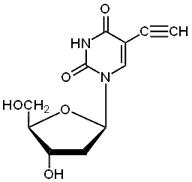EdU (5-ethynyl-2'-deoxyuridine) can be used as a replacement for BrdU (5-bromo-2'-deoxyuridine) and directly measures de novo DNA synthesis or S-phase synthesis of the cell cycle using click chemistry. Click chemistry is a method of covalently coupling an azide with an alkyne. Detection of EdU employs the copper(I) catalyzed click reaction with an azide modified fluorescent dye to form a stable triazole ring. Because of the small size of the click detection reagent, no harsh denaturation steps are needed to gain access to the DNA. Eliminating this step allows for more reproducible results, a simpler and quicker protocol and measurements which can easily be multiplexed with relevant antibody based targets including phospho-histone H3, Ki-67, and cyclin B1 as well as dual-pulse experiments with BrdU by flow cytometry, fluorescence microscopy, microplate (HTS) or high-throughput imaging (HCS).
|
Applications
|

|
| Protocol (PDF): | A012 |
| MSDS (PDF): | MSDS-A012 |
| COA (PDF): | COA-A012 |
Reference:
Proc Natl Acad Sci U S A (2008) 105:2415-2420
Dev Dyn (2009) 238:944-949
Cytometry A (2009) 75:535-546
- Cell-ID™ CFSE Cell Proliferation Kit
- Cell-ID™ Violet Cell Proliferation Kit
- iClick™ EdU Andy Fluor™ 488 Imaging Kit
- iClick™ EdU Andy Fluor™ 555 Imaging Kit
- iClick™ EdU Andy Fluor™ 594 Imaging Kit
- iClick™ EdU Andy Fluor™ 647 Imaging Kit
- iClick™ EdU Andy Fluor™ 488 Flow Cytometry Assay Kit
- iClick™ EdU Andy Fluor™ 647 Flow Cytometry Assay Kit
- iClick™ EU Andy Fluor™ 488 Imaging Kit
- iClick™ EU Andy Fluor™ 594 Imaging Kit
- In Situ BrdU Cell Proliferation Kit
- BrdU
- EU
- Cell-Quant™ No Wash Cell Proliferation Assay Kit
- Cell-Quant™ MTT Cell Proliferation Assay Kit
- Cell-Quant™ AlamarBlue Cell Viability Reagent
